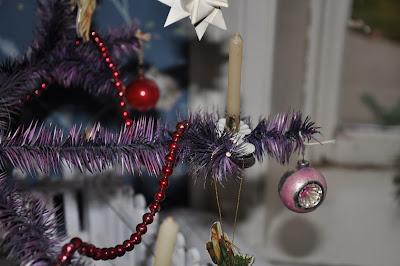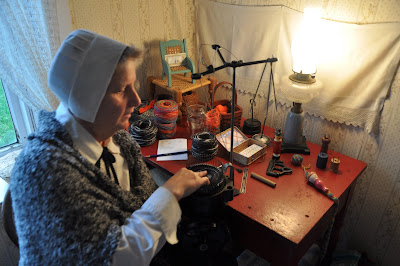Sunday dawned chilly, grey and rainy. Bleh. But I wasn't about to let this keep me in. I called my friend Carrie and off we went to the Waterloo Farm Museum to see what they had to offer for their 1880s Christmas Celebration Weekend.

It took some hunting along the backroads around Waterloo to find the place, but find it we did. As you can see, things were a bit wet and muddy.
The fence was decorated for the season, and after we stepped into the barn, paid our $5 fee, and grabbed a homemade cookie and some cider, we went exploring.
Most of the buildings here are small. One was the gift shop, and another had wreathes and swags for sale. The rest, however, were set up to demonstrate their original uses.
For example, this was the bake house! What a wonderful oven, and along the sides were shelves where no doubt various grains were kept and loaves were set to cool.
Carrie moved some props around so I could get a nice photo.
Ta-da!
The floor housed an old grind stone. We pondered on this for a while. Why was it put here? Was this stone removed because it was worn out and subsequently installed here as a decorative floor? Had the original mill gone automatic? We didn't find an answer.
We were equally fascinated by the roof of the bake house.
What a wonderful collection of mosses and lichens!
One of the buildings was the original farm cabin. Inside they had three volunteers on hand to do some interpreting.
A toasty fire was crackling away and the lady of the house was cooking up some lunch.
They had decked out the place for the holidays. Their tree was decorated with various dried fruit ornaments.
I, of course, was drawn to the bed, with its three quilts!
The tall "barrel" you see just to the right of the door is a section of hollowed out sycamore. The story goes that one winter the folks who lived in the cabin rescued a native woman and her child from a blizzard. The family cared for them and when their health returned, they headed back to their people. The following year, people from the tribe returned to the cabin with this barrel, which was packed full of dried meat, to say thanks for taking care of the woman and child. The family kept the barrel (and apparently stored flour in it).
A few pictures up, you can see a windmill. It is attached to the well, and was the family's source of water.
It was a looooong way down to the water.
Next to the spring house (water pump) was a very short building...mostly under ground.
This was the milk house. Often these buildings were built on, or next to, the spring house, which provided natural cooling inside. The family's milk and butter were stored here. I'm thinking it might also make a pretty nice root cellar.
Next, it was on to the big house, which the family built after living in the little cabin a few years.
Before entering, we had to don blue booties over our muddy shoes - a pretty effective means for keeping the house a little bit cleaner on a wet and muddy day.
In the front parlor we were told all about the many ways folks of this era might have celebrated the holidays. I was most taken by the feather tree, a tradition brought over from Germany in the late 1800s and which became quite popular in the US by the early 1900s.
These little table-top trees are made from feathers, twisted and attached to the branches. The stiff feathers look very much like spruce or fir needles. Candles, of course, were the traditional way to light one's tree. If done correctly, candles on a tree are safe. One should just never leave the room while they are lit. My grandmother used to put candles on her tree (she was of German descent), but I don't recall her ever lighting them. I've only once seen a tree lit with candles, and that was at the house of the family of one of my classmates when I was a kid. It is lovely.
We toured through the second parlor, which was the domain of the woman of the house, and one could only go in there if invited. They had an old pump organ there and a woman played it for us as we passed through.
Continuing around the rooms, we came to a small one where a woman was making socks on an antique sock-knitting machine. The story behind this machine was that there was a woman who was married to a minister. She spent a lot of time knitting socks for her family, time that her husband would be better spent in prayer. So, he invented this machine that turned out socks in a fraction of the time it took to knit them by hand.
While I was quite taken by her socks, and interviewed her at length about her machine, I was also enthralled with the crazy quilt that was on the bed. It had a lot of wonderful embroidery on it, including some great phrases, like the one below ("Laugh and grow fat").
Feathers also featured in artwork upon the walls. This lovely framed arrangement of flowers was made entirely of feathers.
Things were cooking in the kitchen. Although it was a chilly and damp day, it was toasty warm in here. They had bacon frying on the stove and a stew going in the Dutch oven. Next to the stove, on the left, is the wash tub - it was bath day. In fact, one of the women in the kitchen was telling us how that was how her family bathed when she was a kid, and she couldn't have been older than her 60s.
The gentleman in the kitchen regaled us with tales of butter-making. They had a small table-top churn set up to make butter, and they also had this "machine" with some butter on it. The key, he said, to making good butter was to separate the buttermilk from the butter, otherwise your butter would spoil. This could be done in a big bowl, pressing the butter up the sides and pouring out the buttermilk, or in the machine below, which would force the butter up between the paddles, leaving the buttermilk in the pan below, from which you could easily pour it off.
By the time we got upstairs, it was after 3:00 and things were getting dark, thanks to the overcast day. But over all, I had a great time - well worth the price of admission. In fact, I was so taken by this place that I might even consider becoming a volunteer...after all, I love this period of history.

































No comments:
Post a Comment